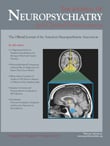Paroxysmal Nonkinesigenic Dyskinesia With Depression Treated by Bilateral Electroconvulsive Therapy
To the Editor: Paroxysmal dyskinesia encompasses a heterogeneous group of disorders, which include paroxysmal kinesigenic dyskinesia, paroxysmal nonkinesigenic dyskinesia, and paroxysmal exertion-induced dyskinesia. 1 ECT is reported to be effective in the treatment of seizure disorders or movement disorders owing to its anticonvulsant effects. 2 , 3 We present the rare case of a patient with depression, who experienced idiopathic and sporadic paroxysmal nonkinesigenic dyskinesia, treated with bilateral ECT.
Case Report
When the patient was 40 and 41 years old, he was treated for major depressive episodes with ECT. His Hamilton Depression Rating Scale score improved from 19 to 12 and 29 to 15, respectively. He complained of his involuntary right upper limb movement in our hospital. When he was 18 years old, involuntary right shoulder and upper limb movement emerged. His involuntary dyskinesia was characterized by a variable degree of movement with a duration of about 1 to 5 seconds. The dyskinesia ranged from the neck to the right shoulder and upper limb. Usually, his right arm moved forward without bending at the elbow. This movement was not like a spasm or tic, but a slow movement lasting for about 3–5 seconds. The frequency of his dyskinesia ranged from 10 to 20 times a day, including brief movements of the right shoulder. We diagnosed his right shoulder and upper limb movement as dyskinesia by ictal video EEG recordings. His consciousness during the seizure was maintained, and there was no postictal confusion. The precipitating factor seemed to be tense situations. Ictal EEG showed no epileptic discharge or electrodecremental pattern in all leads during the seizure. Before, during, and after the ictal period, a 9–10 Hz background rhythm in the occipital area continued, and movement artifacts were seen. Interictal, ictal, and postictal EEG showed no other abnormality (e.g., theta or delta waves). An MRI showed no abnormality, and interictal SPECT (ECD) showed slightly lowered perfusion in the bilateral parietal area. We found no blood electrolyte imbalances or biochemical abnormalities. We tried phenytoin, clonazepam, zonisamide, and valproate; however, these drugs were not effective for his dyskinesia. His depression improved; however, the frequency of his paroxysmal nonkinesigenic dyskinesia did not change by ECT. Nevertheless, after his second ECT, he was able to return to work at his place of employment. Later, topiramate, 300 mg, reduced his seizure frequency to less than half.
Discussion
In this study, we report the case where ECT was used in a patient with depression and paroxysmal nonkinesigenic dyskinesia. Nevertheless, ECT effectively treated our patient’s depression, but not his paroxysmal nonkinesigenic dyskinesia. The pathophysiology of paroxysmal nonkinesigenic dyskinesia is unknown. The reports suggest that the etiology includes dopaminergic dysfunction of the basal ganglia, caudate nuclei, and thalamus. 4 On the other hand there are increasing suggestions of the main therapeutic mechanism of ECT through the GABA neurotransmitter system. 5 In our case, assuming an increased GABA neurotransmitter function induced by ECT, we believe that the treatment effectively relieved the patient’s depression but was ineffective against his paroxysmal nonkinesigenic dyskinesia, which is supposedly associated with dopaminergic dysfunction in subcortical regions of the brain.
1. Demirkiran M, Jankovic J: Paroxysmal dyskinesias: clinical features and classification. Ann Neurol 1995; 38:571–579Google Scholar
2. Regenold WT, Weintraub D, Taller A: Electroconvulsive therapy for epilepsy and major depression. Am J Geriatr Psychiatry 1998; 6:180–183Google Scholar
3. Kennedy R, Mittal D, O’Jile J: Electroconvulsive therapy in movement disorders: an update. J Neuropsychiatry Clin Neurosci 2003; 15:407–421Google Scholar
4. Lombroso CT, Fischman A: Paroxysmal non-kinesigenic dyskinesia: pathophysiological investigations. Epileptic Disord 1999; 1:187–193Google Scholar
5. Sanacora G, Mason GF, Rothman DL, et al: Increased cortical GABA concentrations in depressed patients receiving ECT. Am J Psychiatry 2003; 160:577–579Google Scholar



